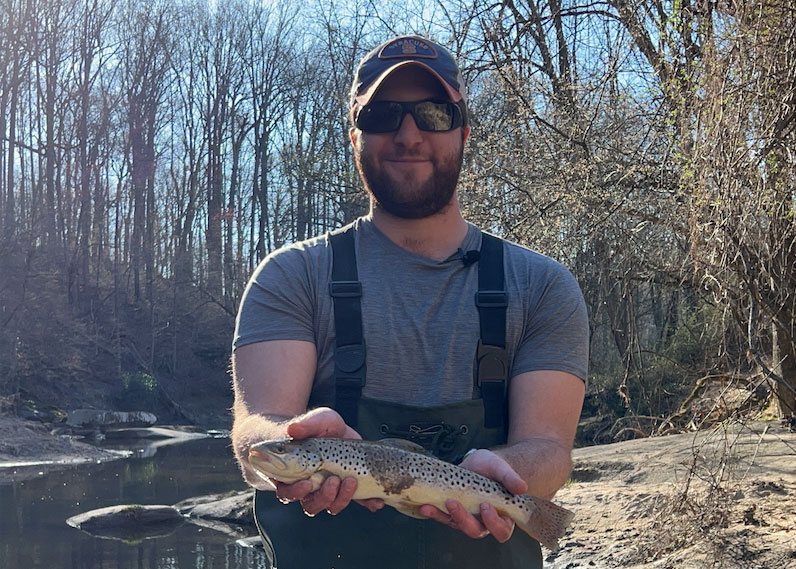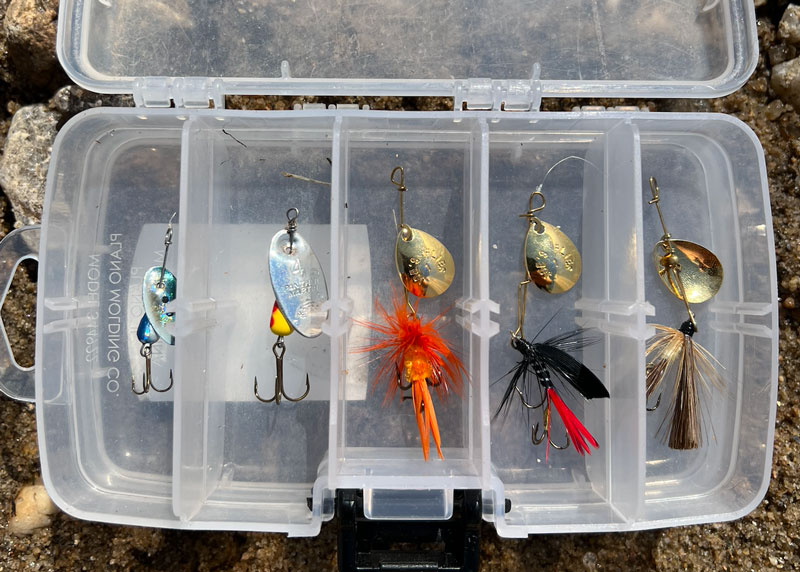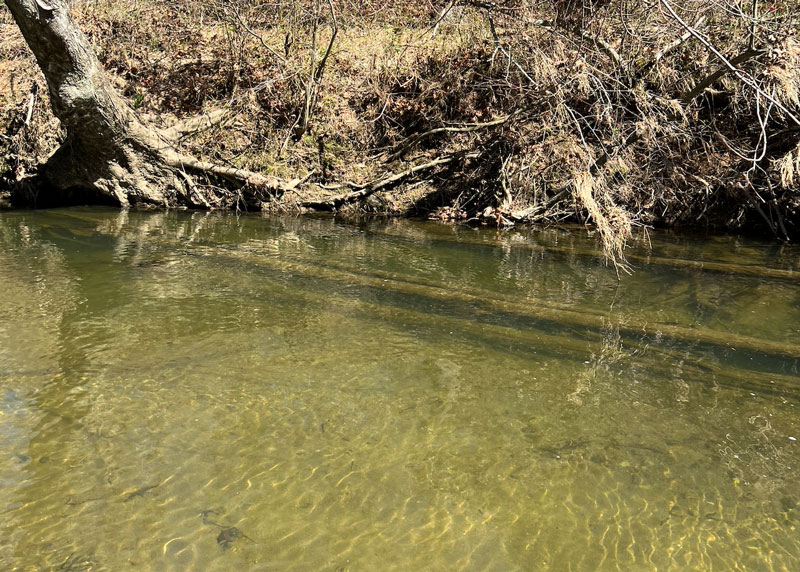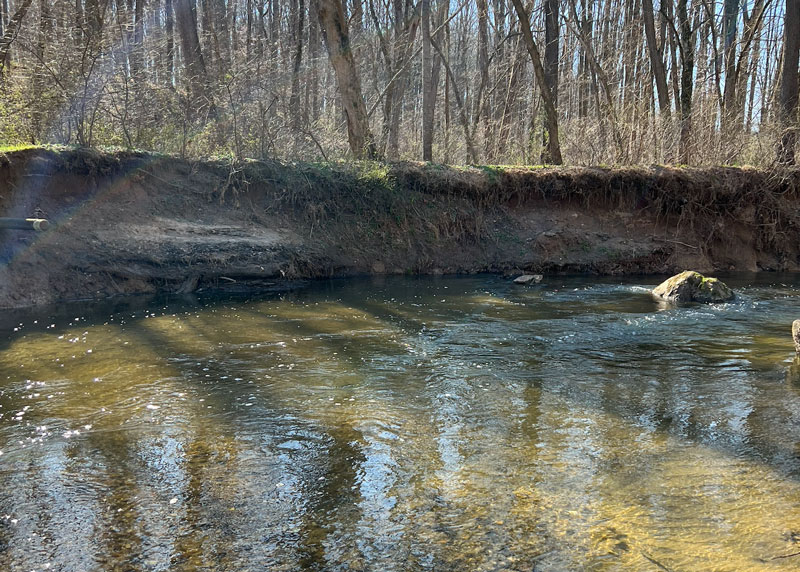You say there's only one "right" way to catch trout? Step aside, fly guys. Conventional fishermen can experience the thrill and beauty of brown trout, too. Catching browns on spinning gear is not complicated, but it requires an understanding of the gear you’ll need, how to read a stream, and the proper approach, casting, and retrieval techniques to catch these colorful fish.

Selecting Spinning Gear
When fishing for brown trout in our local streams, you’ll often be in tight quarters, surrounded by trees and other foliage on the bank. You’ll also be throwing small and lightweight inline spinners (more on this later). So, a 4’8” to 5’0” ultralight rod is the way to go. The shorter length will give you the ability to swing that thing over, under, or around brush without getting snagged on your back-cast. In terms of rod action, go with fast or extra fast. You’ll want to be able to detect every little nibble.
An effective spinning reel for skinny water browns is one that has a higher gear ratio and is lightweight enough to make precision casts. You’ll want the blade of your spinner whipping and flashing as you retrieve it with the flowing current. Use too slow of a reel, and either your lure will just drift as a limp piece of metal with no action, or you’ll wear your arm out trying to crank fast enough to give it action. Accurate casting is also key, as errant casts will often lead to snags on the other bank or in a piece of structure you’re working. All of that being said, grab yourself a 1000 or 1500 size reel with a 6.2:1 or higher gear ratio.
Lightweight and low visibility line is another must. Small inline spinners need light monofilament to maximize their potential. Heavier line will decrease your casting distance and hinder the action of your lure. Remember the importance of sensitivity in your setup, and that using lighter line twill also increase your ability to feel strikes. Brown trout have extremely sharp eyesight and get spooked easily, so choosing clear color line will get you way more bites. Go ahead and spool up with four- to six-pound test.

Now that our rod and reel combo is locked and loaded, it’s time to pick out some lures. Inline spinners are pretty much all you need to catch brown trout in streams. The mix of flash and vibration imitates the plethora of prey that trout consume. Different colors and patterns excel in certain conditions more than others, so make sure to get a good variety. Typically, gold blades do better in low light conditions or in stained water. Silver blades excel in bright sun and clear water. For the spinner body, go with brighter colors like orange, yellow, or red in muddy streams, and natural colors like brown, black, or white in cleaner conditions.
Reading a Stream for Trout
If you’ve never fished a narrow stream and show up expecting to work it like a lake or the Bay, you’re in for a frustrating outing. Hunting brown trout in small streams is finesse fishing at its finest; every detail matters if you expect to land a big one. Read a stream like you read a good book. Get excited by the twists and turns, the structure, the flow.
Areas where the stream turns a corner are ideal ambush spots for trout. The current usually slows around a bend, and all the bugs and baitfish that are drifting through the water slow down with it. This gives the trout an easier opportunity for a meal. Furthermore, the outside of a bend will often form a cut bank due to erosion, giving the trout a place to stay hidden until they spot prey.
Hard structure is another key feature when deciding where to cast in a stream. Imagine yourself as a trout. Where in the water would you hide to ambush a meal? Fallen trees, dams, and boulders all provide cover and points of attack for fish. Casting in and around these natural blinds for a brown on the hunt will frequently result in a strike.

Finally, you’ve got to go with the flow. Areas where the current goes from fast to slow or vice versa are also brown trout hotspots in a stream. These areas typically consist of rapids leading into a slow, deep pool (or the other way around). Especially in the colder months, it is essential to find these areas. A brown trout’s metabolic rate decreases in the winter, so it looks to find warmer water and expend as little energy as possible. Deep pools hold warmth, and the slower current allows the fish to maintain its position without working too hard. Rather than chasing prey down a fast flow, he’ll prefer to not work as hard and wait for a meal to slowly drift by.
Tactics for Approach, Casting, and Retrieving
Finally, we’ve made it to the stream, ready to hunt for a juicy bend, bit of structure, or change in current and depth. Another puzzle now presents itself. Should you head upstream or downstream? Remember, stealth is key for skinny water trout, so if you’re getting in the water to wade, always walk upstream. You’ll stir up mud and silt with each step, and if you were to move downstream, you’d be following this dirtied water much to the fish’s advantage and to your detriment. They’ll know you’re coming well before you approach their position. If you plan to walk the bank there is a little more leeway for heading downstream, but it is still less ideal than traveling upstream. You won’t be stirring up debris, however your shadow may pass over a fish and spook him before reaching your point of attack. Plus, fish generally sit facing the current so they’ll be looking in the direction you’re coming from and could spot your movement.
Go ahead and position yourself downstream of the target you plan to cast at. Now, let’s pick it apart. Toss out your lure so that it lands above the structure, bend, or current change you’re working, and retrieve it back downstream towards you. In the colder months, reel just fast enough to get the metal blades turning. If the weather is warmer, feel free to rip it a little faster. Always stay tight to your spinner. Allowing the slightest amount of slack in your line will cause the lure to drift limp. Never cast downstream and retrieve back up towards you. Trout face upstream waiting to ambush prey drifting down. So, a spinner moving opposite the direction that the stream is flowing is an unnatural presentation and will likely be ignored by fish.
Try to keep your lure in the outside of a bend where the deeper water or cut bank will be. For structure, bring your lure as close to it as possible. Don’t be afraid of getting hung up — you might lose a lure, but you could also miss out on a fish lurking within a dam or laydown waiting to ambush your offering. If you’ve found a slow flowing, deep pool either above or below some rapids, cast upstream and retrieve your lure through the transition zone from fast to slow (or slow to fast) all the way back to where you’ve set up downstream.

One final word of advice: follow the foam. Foam lines in a stream give an indication of where the current is collecting debris, including trout food. Fish will often be staged close to these lines, so retrieving your spinner along them would be wise.
Walking a stream for brown trout can be incredibly peaceful, therapeutic, and rewarding. Employ these tactics and experience the beauty and majesty of brown trout for yourself, with your spinning gear in hand.
-By Adam Greenberg